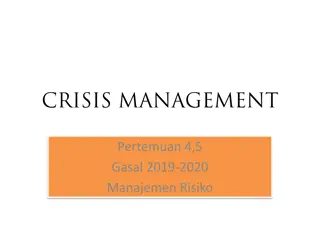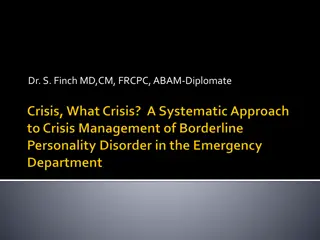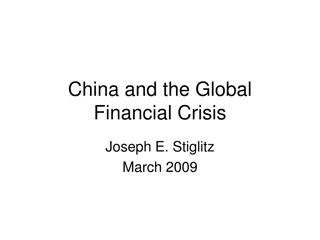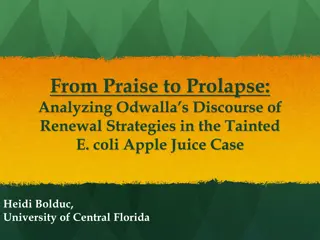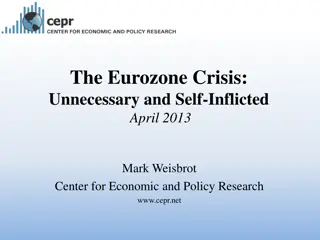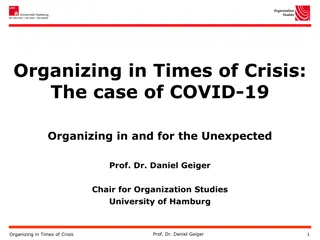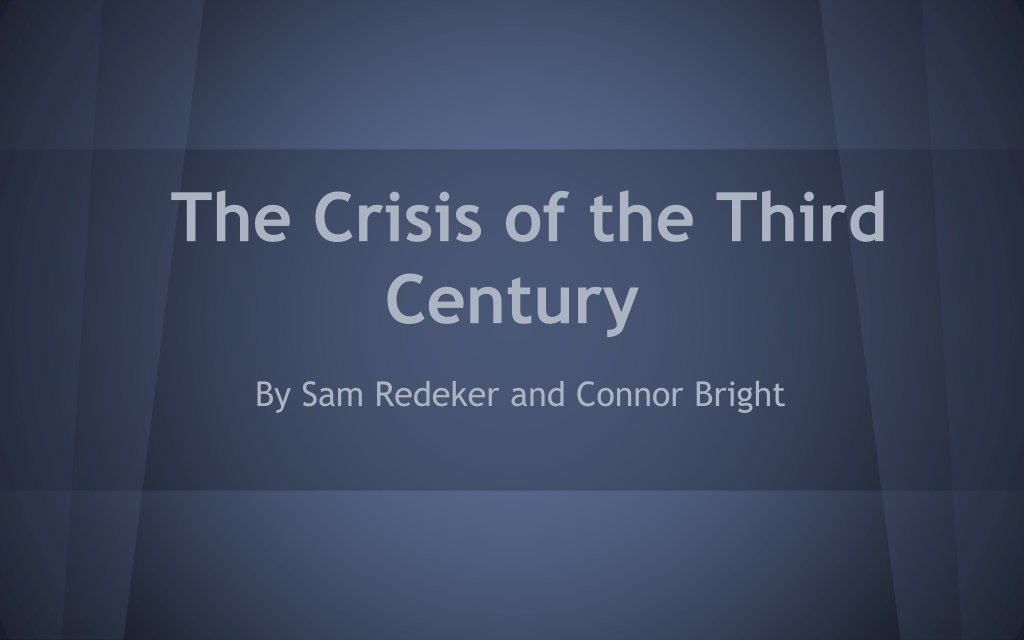
The Crisis of the Third Century: A Turbulent Period in Ancient Rome
Explore the tumultuous era known as the Crisis of the Third Century (235-284 CE) in Ancient Rome, marked by civil war, economic collapse, invasions, and a succession of emperors. From the pre-crisis Severan Dynasty to the reign of Emperor Decius and the battles against Persians and barbarians, delve into the chaotic events that shaped this pivotal period in Roman history.
Download Presentation

Please find below an Image/Link to download the presentation.
The content on the website is provided AS IS for your information and personal use only. It may not be sold, licensed, or shared on other websites without obtaining consent from the author. Download presentation by click this link. If you encounter any issues during the download, it is possible that the publisher has removed the file from their server.
E N D
Presentation Transcript
The Crisis of the Third Century By Sam Redeker and Connor Bright
The Basics: Lasted about 50 years (235-284 CE) Events that transpired during the Crisis include: o 23 people were crowned Emperor/Co-Emperor/Junior Emperor. Some of these people died in battle, some were assassinated, and some just disappeared. o Plague of Cyprian devastated the Roman people. o Civil War o The division of Rome o Many invasions o The collapse of the economy.
Pre-Crisis (200-235 CE) Severan Dynasty Emperors/Co-Emperors o Septimus Severus: 193-211 CE o Caracalla (Septimus oldest son: 198-217 CE (assassinated) o Geta (Septimus youngest son): 209-211 CE (killed by Caracalla) o Macrinus (Caracalla s prefect): 217-218 CE (executed) o Elagabalus (Septimus great-nephew): 218-222 CE (assassinated) o Alexander Severus (Septimus other great-nephew): 222-235 CE (assassinated by his own troops) Beginning of the Crisis of the Third Century
235-239 CE 235: Maximinus Thrax becomes emperor 238: Gordianus, proconsul of Africa, and his son declared Emperor and Co-Emperor by the Roman senate. They are killed by Maximinus Thrax and legions still loyal to him. Senators Pupienus and Balbinus also killed. Maximinus later killed in a mutiny. A brief Civil War occurs. o M. Antonius Gordianus Pius III declared emperor. 239: Lower Moesia repels Gothic invasion.
240-249 CE 240: Rebellion in Africa put down near Carthage. 242: Gordianus III has the Temple of Janus built. He then repels the Persian army from the city of Antioch. Cimmerian cities in the Bosphorus now controlled by Ostrogoths. 244: Gordianus III dies of a mortal wound. The suspect, Philippus, becomes Emperor. 248: Goths and Germans defeated. Legions unhappy. Failed rebellion. This leads to another rebellion. 249: Goth tribes attack northern cities, but are defeated by General Trajanus Decius, who upon being declared Emperor by his men, marches into Rome, defeats Philippus, and becomes Emperor. Philip s eleven year-old son is also killed.
250-259 CE 250: First time a Roman Emperor fled from barbarians. 251: Plauge of Cyprian breaks out (possibly smallpox). Decius and his son killed in battle. His youngest son is killed by the plague. 252: Trebonianus Gallus declared emperor. Persia and Gothic tribes invade. Persia takes Syria and Armenia. 253: Aemilianus, Governor of Moesia, defeats Goths. After his soldiers declare him Emperor, he kills Trebonius, but in turn is also murdered. Valerianus and his son Gallienus declared Co-Emperors. 254: Pannonia lost to Macromanni 255: Province of Dacia lost to barbarians. 256-259: Battles against the Persian, Goths, and other barbarians rage on. Plague decimates the Eastern Legions.
260-269 CE 260: Persian army destroys Rome s Eastern army in Edessa. Tens of thousands of Roman troops, including the Emperor, taken into captivity. Valerianus is killed and actually taxidermied as a trophy. Gaul, the Germanies, Britain, and Spain break off from Rome to form the Gallic Empire. Syria, Egypt, and Palestine break off from Rome to form the Palmyrene Empire. 262: Gallienus begins the separation of civil and military functions. 268: Gallienus assassinated. Claudius II becomes emperor.
270-279 CE 270: Claudius II dies from the plague. Aurelianus becomes Emperor. 273-274: Aurelianus reunites the Gallic and Palmyrene Empires with Rome. 275: Aurelianus is murdered. His widow, Ulpia Severina, becomes Empress. 276: Marcus Claudius Tacitus becomes Emperor (unclear what happened to Ulpia). He gets sick and dies. Florianus tries to become Emperor, but he is killed in a mutiny staged by Marcus Aurelius Probus. 277: Probus elected consul. 278: Probus elected consul for the second time. 279: Probus elected consul for the third time.
280-285 CE 280: Rome battles the Burgundi and Vandal tribes. Roman rebellion in the Rhine crushed by local Roman troops. 282: Probus killed while marching against Persia. Carus becomes Emperor and his sons Carinus and Numerian become Junior Emperors. 283: Carus dies. Carinus and Numerian become Co-Emperors. 284: Numerian dies under suspicious circumstances. Carinus becomes Emperor, but Gaius Aurelius Valerius Diocletianus battles him for the throne. 285: Diocletian defeats Carinus and becomes Emperor. This is the offical end of the Crisis of the Third Century.
Why So Many Emperors? So many people died as the Emperor or to become the Emperor because during the Third Century, a number of things were going wrong at the same time. The main causes were: Economic Problems The Plague of Cyprian Invasions Civil Wars and Rebellions.
Economic Problems Hyperinflation caused by years of overspending. o Aurei (gold coins) was still worth something, but denarii became basically useless. Trade network disrupted. o People who relied on imports and/or exports were hurt badly. Increased Localism o Smaller parts of the Empire were basically on their own. http://en.wikipedia.org/wiki/File:Marcus_Aurelius_ Denarius2.jpg http://images-00.delcampe- static.net/img_large/auction/000/172/644/171_0 03.jpg
The Plague of Cyprian 250-266: Beginning/height of the outbreak o About 5,000 Roman s were killed by the Plague per day. 270: The Plague took the life of Emperor Claudius II Gothicus. Today, this Plague is thought to have been smallpox.
Invasions Rome was invaded by multiple enemies many times throughout the Century, including the Ostrogoths (Goths), the Persians, Germanic tribes, and other barbarians. o Many Generals who successfully repelled invasions were encouraged by their troops to try to take over as Emperor. Some were successful while others efforts were not as fruitful. o The Gallic and Palmyrene Empires broke from Rome with the help of these invading powers. Outside of many frontiers, raids began to get more and more frequent and more and more destructive. o The Parthian ruler was determined to gain his empire s former glory back, so he began attacking Rome. Persians as well planned to deal with Rome The Persian army had already defeated 3 Roman armies from the different emperors.
Civil Wars When Maximinus Thrax was killed, a civil war raged for about a year. Another rebellion resulted in two new Empires splitting off from Rome. Gallic Empire Broke off from Rome in 260 CE under Postumus. Based in Gaul, the Germanies, Britain, and Spain (which broke off from the Gallic Empire in 269 CE). Reintegrated into Rome after being defeated by Aurelianus in 274 CE. Palmyrene Empire Broke off from Rome in 260 CE under Queen Zenobia with the support of Persia Based in Syria, Egypt, and Palistine. Reintegrated into Rome after being defeated by Aurelianus in 273 CE.
Whats Next? Diocletia n http://www.conservapedia.com/images/thumb/5/5c/Diocletian.jpg/200px-Diocletian.jpg
Bibliography "Crisis of the Third Century." Crisis of the Third Century. Accessed April 22, 2014. http://en.wikipedia.org/wiki/Crisis_of_the_Third_Century. "The Crisis of the Third Century." Saylor. Accessed April 15, 2014. http://www.saylor.org/site/wp-content/uploads/2013/02/HIST301-7.2.4- CrisisThirdCentury-FINAL.pdf. "Diocletian." Digital image. Accessed April 28, 2014. http://www.conservapedia.com/images/thumb/5/5c/Diocletian.jpg/200px-Diocletian.jpg. "Map of Ancient Rome 271 AD." Digital image. Wikipedia. Accessed April 25, 2014. http://en.wikipedia.org/wiki/File:Map_of_Ancient_Rome_271_AD.svg. A picture of Aurei (A Gold Coin). Digital image. Accessed April 25, 2014. http://images-00.delcampe- static.net/img_large/auction/000/172/644/171_003.jpg. "Plague of Cyprian." Wikipedia. Accessed April 24, 2014. http://en.wikipedia.org/wiki/Plague_of_Cyprian. Rydman, Sampsa. "Crisis of the 3rd Century Timeline." Crisis of the 3rd Century Timeline. 2010. Accessed April 17, 2014. http://antiikki.taivaansusi.net/timeline.html. Southern, Pat. "Third Century Crisis of the Roman Empire." BBC News. February 17, 2011. Accessed April 25, 2014. http://www.bbc.co.uk/history/ancient/romans/thirdcenturycrisis_article_01.shtml. "Timeline of the Roman Empire." Wikipedia. Accessed April 15, 2014. http://en.wikipedia.org/wiki/Timeline_of_the_Roman_Empire#Crisis_of_the_Third_Century_.28235_to_285.29. Tingay, Graham, and John Badcock. These Were the Romans. Chester Springs, PA, USA: Dufour Editions, 1989. Pages 196-197


